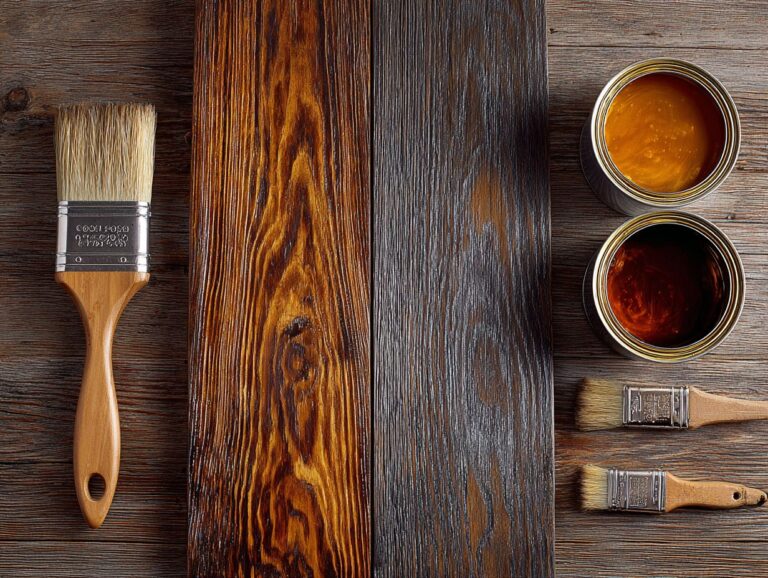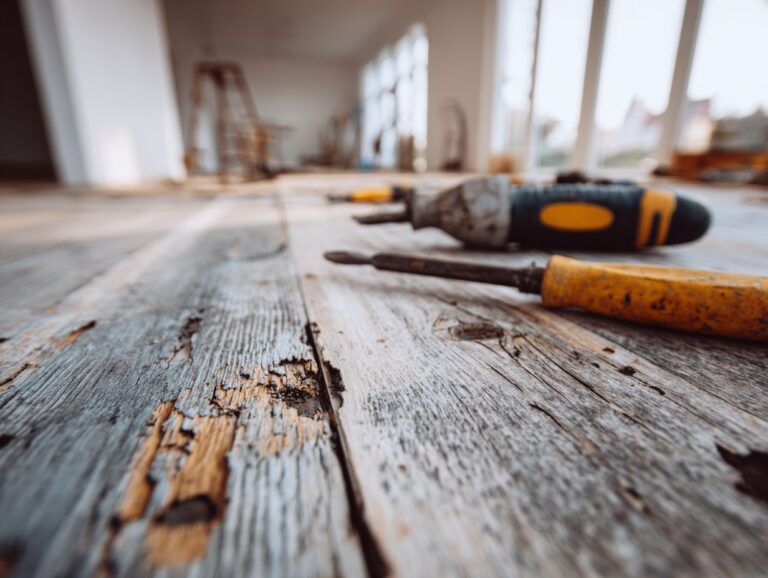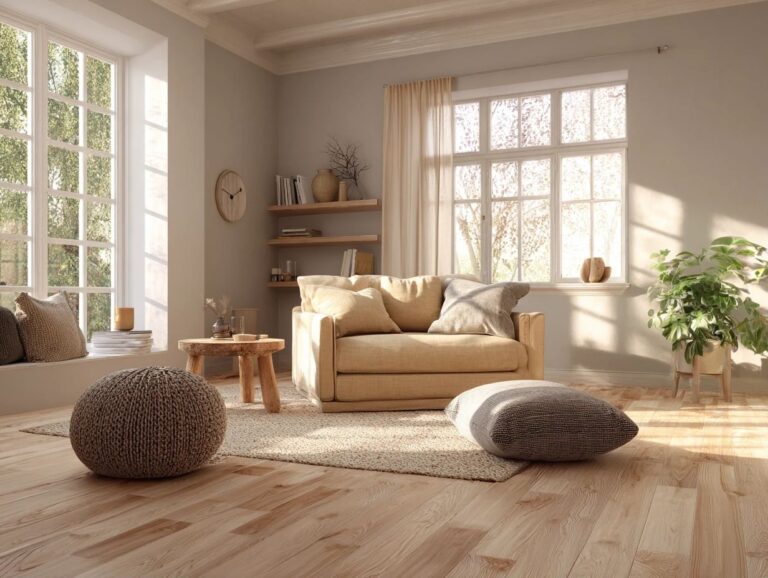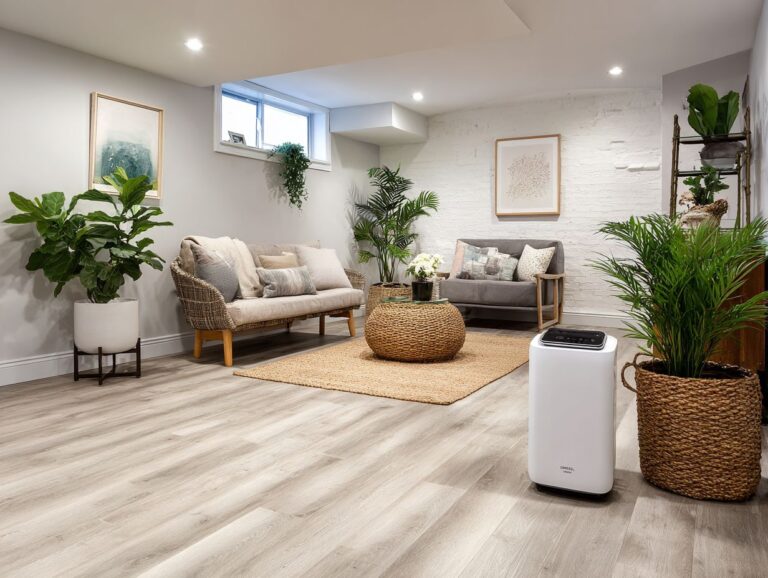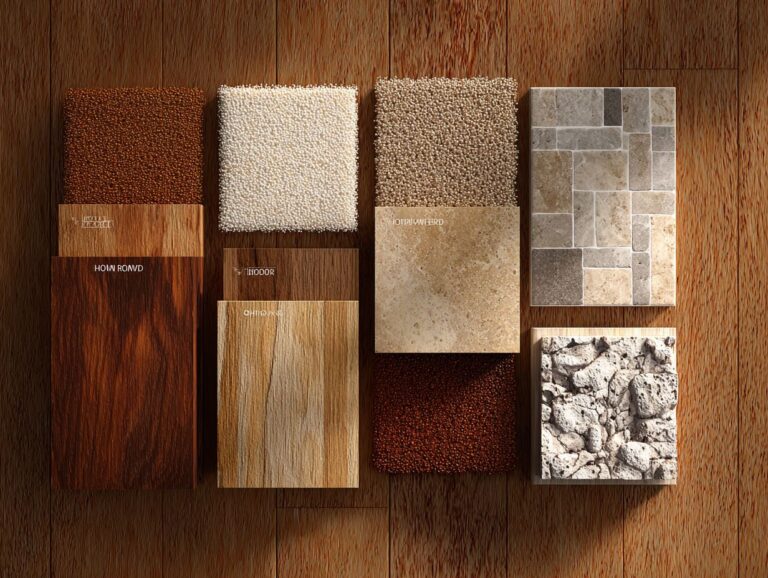Flooring Impact on Home Sale Price – Realtor Insights
When improving your home’s worth, flooring is very important for resale value. According to the National Association of REALTORS and USA Today, quality materials like hardwood flooring can offer significant return on investment. This article explains how selecting the right flooring can raise your home’s sale price, giving useful advice for homeowners to make informed decisions. Learn how flooring affects your property’s appeal to buyers!
Key Takeaways:
Contents
- Types of Flooring and Their Value
- Flooring Quality and Home Appeal
- Flooring Trends Impacting Sale Prices
- Flooring and Home Sale Price Statistics
- Regional Variations in Flooring Preferences
- Calculating the ROI of Flooring Upgrades
- Common Flooring Mistakes to Avoid
- Frequently Asked Questions
- What is the impact of flooring on home sale price?
- What types of flooring are most desirable for increasing home sale price?
- Can outdated flooring negatively affect the sale price of a home?
- Is it worth investing in high-quality flooring for a home sale?
- How can a Realtor help with flooring choices for a home sale?
- Are there any flooring options to avoid for a home sale?
Importance of Flooring in Real Estate
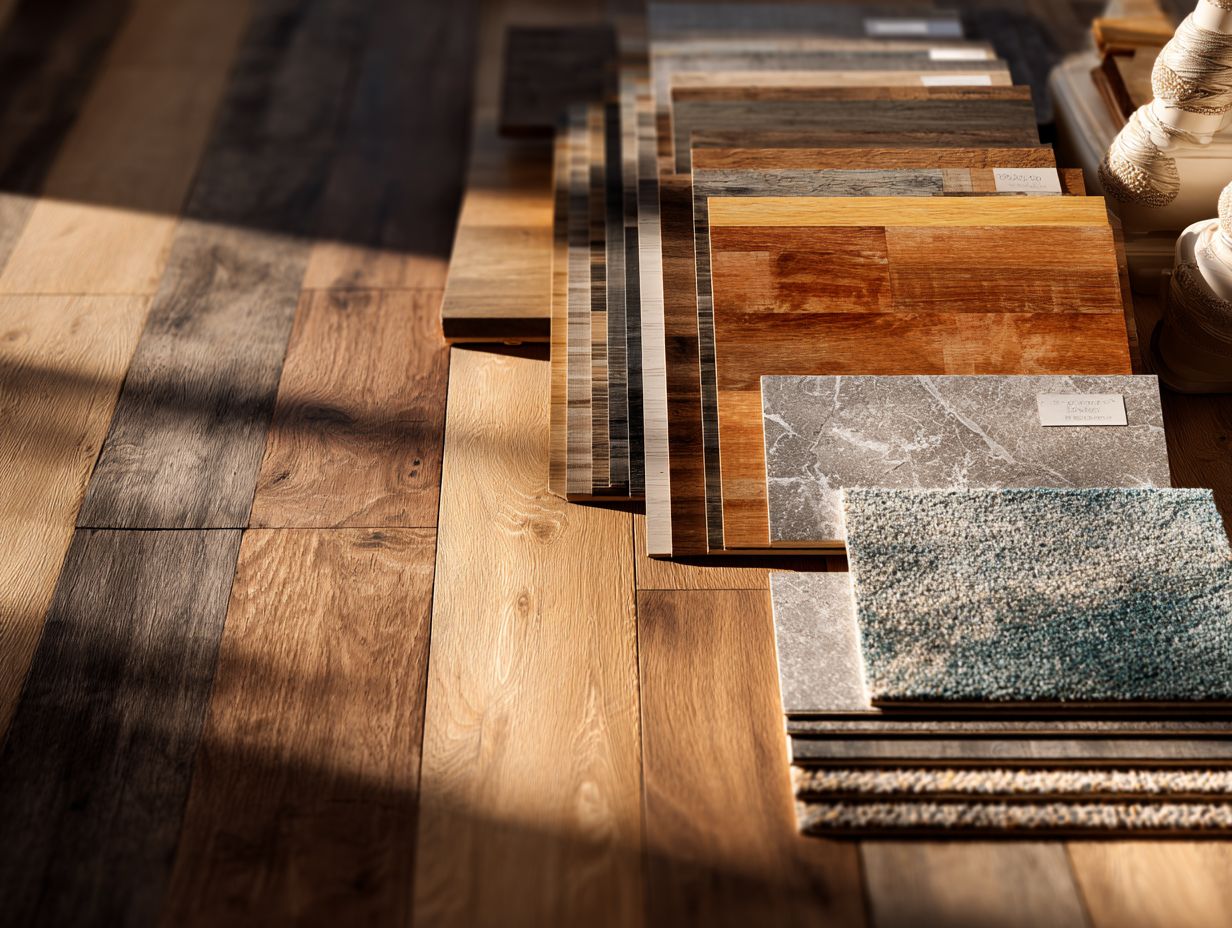
Flooring significantly impacts first impressions, with studies indicating that homes with high-quality flooring can sell for up to 10% more.
Upgrading flooring improves how a home looks and changes how buyers see it. For instance, transitioning from worn carpet to hardwood can create a more spacious and luxurious feel.
According to the National Association of REALTORS, buyers often associate premium flooring with better overall maintenance and care of the property. Choices like engineered hardwood and luxury vinyl plank are both stylish and long-lasting, attracting many possible buyers.
Choosing the right flooring can help sell your property faster and attract more bids.
Overview of Market Trends
Current market trends reveal a shift towards eco-friendly and durable flooring options, reflecting buyer preferences in home purchases.
Luxury vinyl plank (LVP) has surged in popularity, now accounting for 25% of the flooring market, thanks to its water-resistant properties and realistic wood-like appearance. In contrast, traditional carpet sales have dropped by 15%, mainly due to concerns about allergens and maintenance.
As consumers prioritize sustainability, brands like COREtec and Karndean have started producing LVP using recycled materials. Bamboo and cork are gaining traction as eco-friendly alternatives, appealing to environmentally-conscious buyers looking for stylish yet practical solutions.
Types of Flooring and Their Value
Different flooring types can affect how attractive a home is and how much it might sell for, influencing both resale value and the look of the home.
Hardwood Flooring
Hardwood flooring remains a top choice among homebuyers, often leading to a 70-80% return on investment (ROI) upon resale.
With proper care, it can last for decades. For instance, select species like oak and maple are durable and give a timeless look that improves any room’s appearance.
Installation costs can range from $8 to $14 per square foot, depending on the wood type and complexity of the setup. Regular maintenance involves simple tasks like sweeping and occasionally refinishing every 5-10 years, which maintains its look and value.
Hardwood is attractive and durable, making it a wise choice.
Laminate Flooring
Laminate flooring, known for its affordability and variety, can offer up to 50-70% ROI, appealing to budget-conscious homeowners.
This flooring option comes in diverse designs, mimicking natural wood and stone textures with impressive realism. Setting it up is simple and typically requires basic tools such as a saw and measuring tape, making it suitable for those who like DIY projects.
In fact, about 80% of homeowners start their projects without professional help. Laminate flooring usually meets energy efficiency standards, often featuring a low VOC rating, which contributes to better indoor air quality.
As a result, it has gained popularity, representing more than 20% of the current flooring market.
Tile Flooring
Tile flooring provides a luxurious look and durable surface, often increasing a home’s market appeal, especially in wet areas like kitchens and bathrooms.
Ceramic tile is cost-effective and available in a variety of colors and patterns, making it ideal for those looking for stylish options without spending much.
Porcelain tile is more durable and resistant to water, which makes it ideal for places with a lot of moisture. Putting a shiny porcelain tile in a bathroom can make it feel like a relaxing spa.
These tiles improve the look of a home and can increase its value, drawing interest from buyers who want modern features.
Carpet Flooring
While carpet flooring offers comfort and warmth, its appeal has diminished, resulting in a lower ROI compared to hard surfaces.
This is particularly true in high-traffic areas, where carpets can wear quickly and become stained, impacting resale value.
Maintenance requirements can be extensive, with regular vacuuming and periodic deep cleaning.
If you choose high-quality, stain-resistant carpets, like those made with nylon or polyester, they can last longer and withstand wear. Carpets may be less appealing to allergy sufferers, as they can trap dust and allergens.
Unlike carpets, hard surfaces like hardwood or tile are simpler to keep clean and don’t trap allergens. They are a smarter choice over time.
Luxury Vinyl Plank (LVP)
Luxury Vinyl Plank is gaining popularity due to its aesthetic versatility and durability, often providing up to 70% ROI when installed correctly.
One big benefit of LVP is that it doesn’t get damaged by water, so it’s perfect for places where spills happen often, like kitchens and bathrooms.
Unlike hardwood and tile, which can be sensitive to humidity and temperature changes, LVP maintains its integrity without warping or cracking. It offers a scratch-resistant surface that mimics high-end materials such as natural wood or stone.
When comparing installation costs, LVP averages around $2 to $7 per square foot, significantly less than hardwood at $8 to $15 and tile at $5 to $10, resulting in savings without sacrificing style.
Flooring Quality and Home Appeal

The condition and look of flooring can greatly influence how buyers view a home and its attractiveness during a sale.
How Quality Affects Buyer Perception
Good flooring can make a strong first impression, which is important in real estate since buyers often make quick decisions.
Choosing the right flooring materials can significantly influence a home’s marketability. Consider materials such as hardwood. They provide a timeless appearance and can increase home value by 2.5% to 10%.
Alternatively, luxury vinyl planks offer durability and aesthetic versatility at a lower cost. To improve the look, use area rugs that match your flooring.
Consider using light-colored finishes to make spaces feel larger and more inviting, which is particularly appealing to potential buyers during showings.
Durability and Maintenance Considerations
Choosing durable flooring options is essential for longevity and requires less maintenance, appealing to today’s discerning buyers.
Hardwood, tile, and luxury vinyl are popular choices, each varying in durability and maintenance needs.
Hardwood looks nice and feels cozy, but it can get scratched or stained. You have to refinish it every 5 to 10 years.
Unlike other materials, tile lasts a long time and doesn’t get damaged by water, which makes it perfect for kitchens and bathrooms. But you need to clean the grout.
Luxury vinyl combines the best of both worlds-it’s both resilient and easy to clean, yet still looks stylish.
Depending on your lifestyle, think about how much foot traffic and moisture your space encounters to make the best choice.
Flooring Trends Impacting Sale Prices
New flooring styles are affecting what buyers like and can greatly affect the price of homes being sold now.
Flooring and Home Sale Price Statistics
Flooring and Home Sale Price Statistics
Flooring Impact on Home Value: Cost Recovery Rates
Flooring Impact on Home Value: Sales Data
Flooring Impact on Home Value: Volume Data
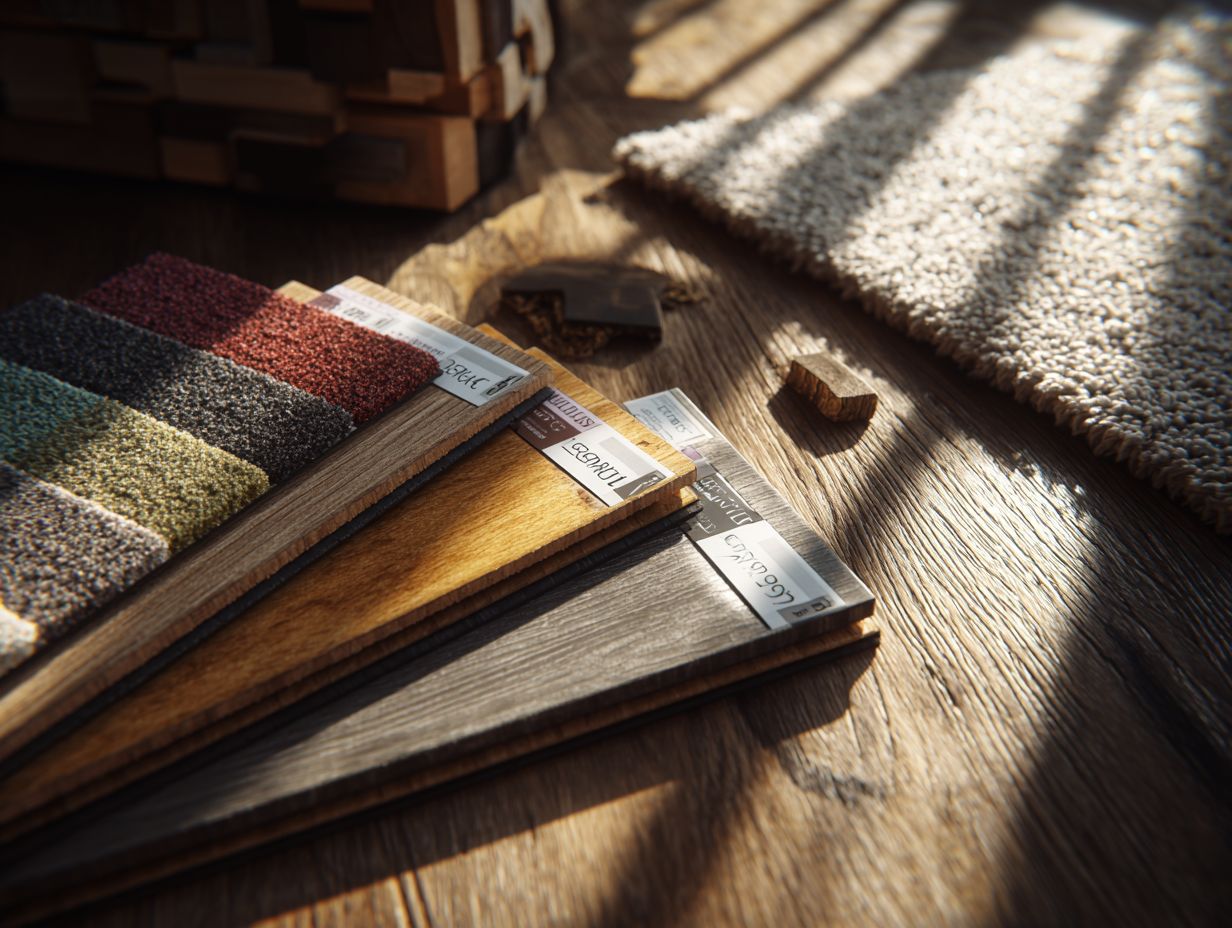
The Flooring and Home Sale Price Statistics provide information on how different flooring affects home prices, current market trends, and how homes sell. This data highlights the significant role flooring plays in real estate and market preferences, with a focus on resilient flooring.
Flooring Impact on Home Value demonstrates the high cost recovery rates for refinishing hardwood floors, at 147%, illustrating that homeowners can recoup more than what they invest in refinishing projects. Similarly, installing new wood floors offers a 118% recovery rate, making both choices financially beneficial for those wanting to raise their home’s resale value.
- Market Share: The rise in resilient flooring market share from 11.9% in 2013 to 34% in 2023 indicates a significant shift towards materials known for durability and low maintenance. The popularity of Luxury Vinyl Tile (LVT), which comprises 48.6% of the resilient flooring market in 2023, highlights consumer preference for its aesthetic versatility and water resistance.
Sales Data reveals a slight decline in resilient flooring sales, from $9.46 billion in 2022 to $8.55 billion in 2023. This shift could be due to economic factors impacting consumer spending or market saturation. Despite the decline in sales, the durable nature of resilient flooring maintains its popularity.
Volume Data shows a reduction in resilient flooring volume from 6,206 million square feet in 2022 to 5,768 million square feet in 2023. This decrease aligns with the sales data, suggesting a market correction or increased efficiency in production and installation processes.
Overall, the Flooring and Home Sale Price Statistics highlight the worth and market trends of durable and hardwood flooring. Flooring choices significantly impact home value and market trends, with resilient flooring maintaining a strong presence despite recent sales declines. This information explains why wise spending on flooring matters for both homeowners and those in the industry.
Current Popular Flooring Styles
Popular flooring styles like wide-plank hardwood and patterned tiles are capturing buyer interest and increasing market appeal.
Wide-plank hardwood provides a classic appearance and makes rooms look larger, suitable for both new and traditional homes.
In contrast, patterned tiles bring vibrancy and personality to high-traffic areas like kitchens and entryways. For instance, encaustic cement tiles can serve as a stunning kitchen backsplash, while natural stone tiles provide durability and a touch of luxury.
To improve these styles, think about adding accent rugs or matching wall colors. This can improve the look without making the space feel tight.
Eco-Friendly Flooring Options
The rise of eco-friendly flooring options reflects growing consumer demand for sustainable materials, often translating into higher home values.
Materials like bamboo and reclaimed wood attract eco-friendly buyers and increase property values.
For instance, homes featuring bamboo flooring can see a price premium of 3-5%, as this material is renewable and durable. Reclaimed wood, often sourced from older buildings, offers unique aesthetic charm while reducing waste.
This popularity is supported by studies showing that homes with sustainable finishes often sell faster in the market. By choosing eco-friendly flooring, homeowners improve their homes and help the environment. As mentioned, different flooring materials can add varying levels of value to a home, as detailed in our guide to Flooring ROI by Material.
Regional Variations in Flooring Preferences
Choices in flooring differ widely by area, affected by things like weather, daily habits, and local market trends.
Urban vs. Suburban Preferences
Urban buyers often prefer stylish, low-maintenance flooring options, while suburban buyers may lean towards traditional and durable choices.
In cities, popular flooring options include smooth laminate and shiny concrete, which attract buyers who want a modern look and easy maintenance.
For example, wide-plank laminate mimics wood without the high maintenance, attracting young professionals. Conversely, suburban buyers often gravitate towards hardwood and quality vinyl tiles that offer warmth and durability, essential for family homes.
These choices reflect lifestyle differences: urbanites prioritize design and convenience, while suburban families value long-lasting materials conducive to more extensive daily use.
Climate Influence on Flooring Choices
Regional climates greatly affect which flooring types are appropriate, influencing how long they last and the care they need.
For example, in humid climates, moisture-resistant materials like vinyl or tile are essential, as they can withstand high humidity without warping.
Conversely, dry regions benefit from hardwood or laminate, which offers aesthetic appeal and durability in arid conditions. Carpet can be advantageous in cooler climates, providing warmth and insulation.
Temperature fluctuations may also necessitate considering materials with good thermal retention, such as cork. Choosing the best flooring means considering local climate and finding a balance between looks and usefulness.
Calculating the ROI of Flooring Upgrades
Figuring out the return on investment (ROI) for new flooring is important for homeowners wanting to increase their property’s value.
Cost vs. Value Analysis
Doing a thorough cost and value comparison can help homeowners see which flooring improvements offer the best return on investment.
According to the Remodeling Impact Report, materials like hardwood typically cost between $5 to $10 per square foot but can increase a home’s value by about $20,000 for a 2,500-square-foot home.
In contrast, laminate flooring costs around $1 to $3 per square foot and generally adds a modest $5,000 to $7,000.
Even more affordable options, like vinyl, which can range from $2 to $5 per square foot, tend to provide a neutral impact on overall home value.
Homeowners should weigh initial costs against potential returns to make informed decisions.
Case Studies of Successful Upgrades
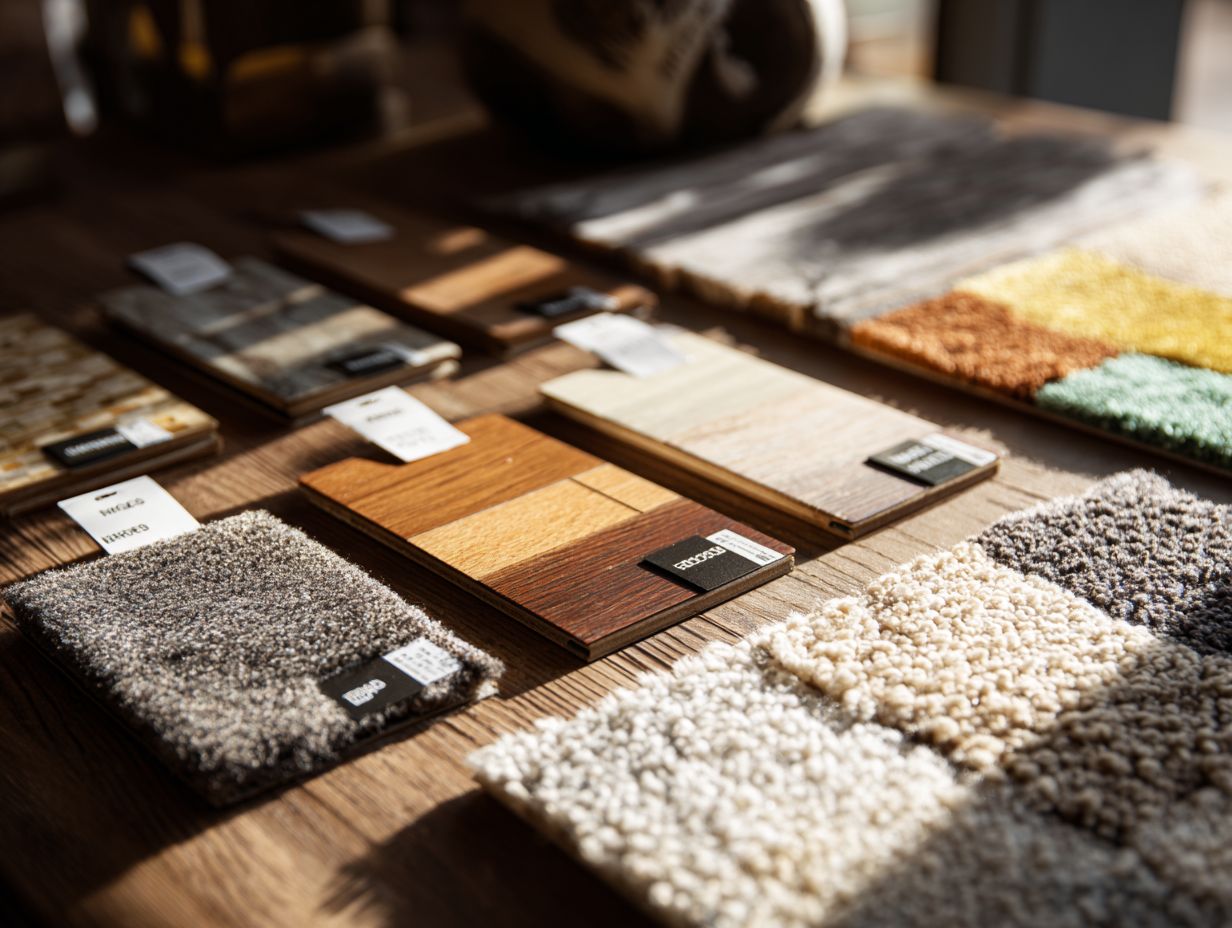
Real-life case studies reveal how strategic flooring upgrades have successfully increased home sale prices across various markets.
One notable example is a home in suburban Atlanta, where the owners replaced outdated carpet with luxury vinyl planks for $7,000, resulting in a $20,000 increase in their sale price.
In the same way, a property in San Diego that spent $10,000 on high-quality tile for the kitchen and bathrooms increased its market value by $30,000.
These cases highlight the powerful return on investment that can be achieved through thoughtful flooring choices, emphasizing the importance of selecting materials that appeal to potential buyers.
Common Flooring Mistakes to Avoid
Preventing typical flooring errors can help homeowners save a lot of time and money and increase the value of their home. To ensure your installation is foolproof, consider adopting the techniques outlined in our Glue-Down Flooring Installation – Best Practices guide.
Choosing Inappropriate Materials
Choosing inappropriate flooring materials can lead to decreased home value and deter potential buyers during showings.
For instance, putting in wall-to-wall carpeting in an area with high humidity can lead to mold, causing buyers to think twice about the property. Alternatively, opting for dark tiles in small, naturally dim rooms can make spaces feel even more cramped.
To avoid these pitfalls, research local trends and consult with real estate agents on preferred materials. Using resources like HomeAdvisor can help you find good flooring options nearby, allowing you to make informed decisions that improve how your home looks.
Neglecting Installation Quality
Neglecting professional installation can result in flooring failures that diminish home value and increase maintenance costs.
Take, for instance, a homeowner who attempted to install laminate flooring themselves. The improperly aligned planks created gaps, leading to moisture damage and a subsequent $2,000 repair bill.
One family’s experience showed that hiring a certified installer made sure everything was correctly aligned and increased their home’s value by 15%.
To prevent problems, think about using trusted flooring services such as Angie’s List or HomeAdvisor, which offer checked professionals specific to your location.
Frequently Asked Questions
What is the impact of flooring on home sale price?
Realtors say that the type of flooring can significantly affect the selling price of a house. It is one of the first things potential buyers notice and can greatly affect their perception of the property.
What types of flooring are most desirable for increasing home sale price?
Hardwood flooring is often seen as the most desirable and can significantly increase the sale price of a home. Other popular options include tile, laminate, and luxury vinyl.
Can outdated flooring negatively affect the sale price of a home?
Yes, outdated or damaged flooring can decrease the value of a home and make it less appealing to potential buyers. It is often recommended to update flooring before putting a home on the market.
Is it worth investing in high-quality flooring for a home sale?
In most cases, yes. Upgrading to high-quality flooring can increase the sale price and attract more buyers. It can also help a home sell faster and with less negotiation on price.
How can a Realtor help with flooring choices for a home sale?
A Realtor can give useful information and suggestions on the flooring choices favored in the area and which might bring the highest profit. They can also connect sellers with reputable flooring professionals.
Are there any flooring options to avoid for a home sale?
While personal preferences may differ, some flooring options may not appeal to the majority of buyers and could negatively impact the sale price. This includes bright or vivid carpets, old-fashioned linoleum, or inexpensive laminate.
